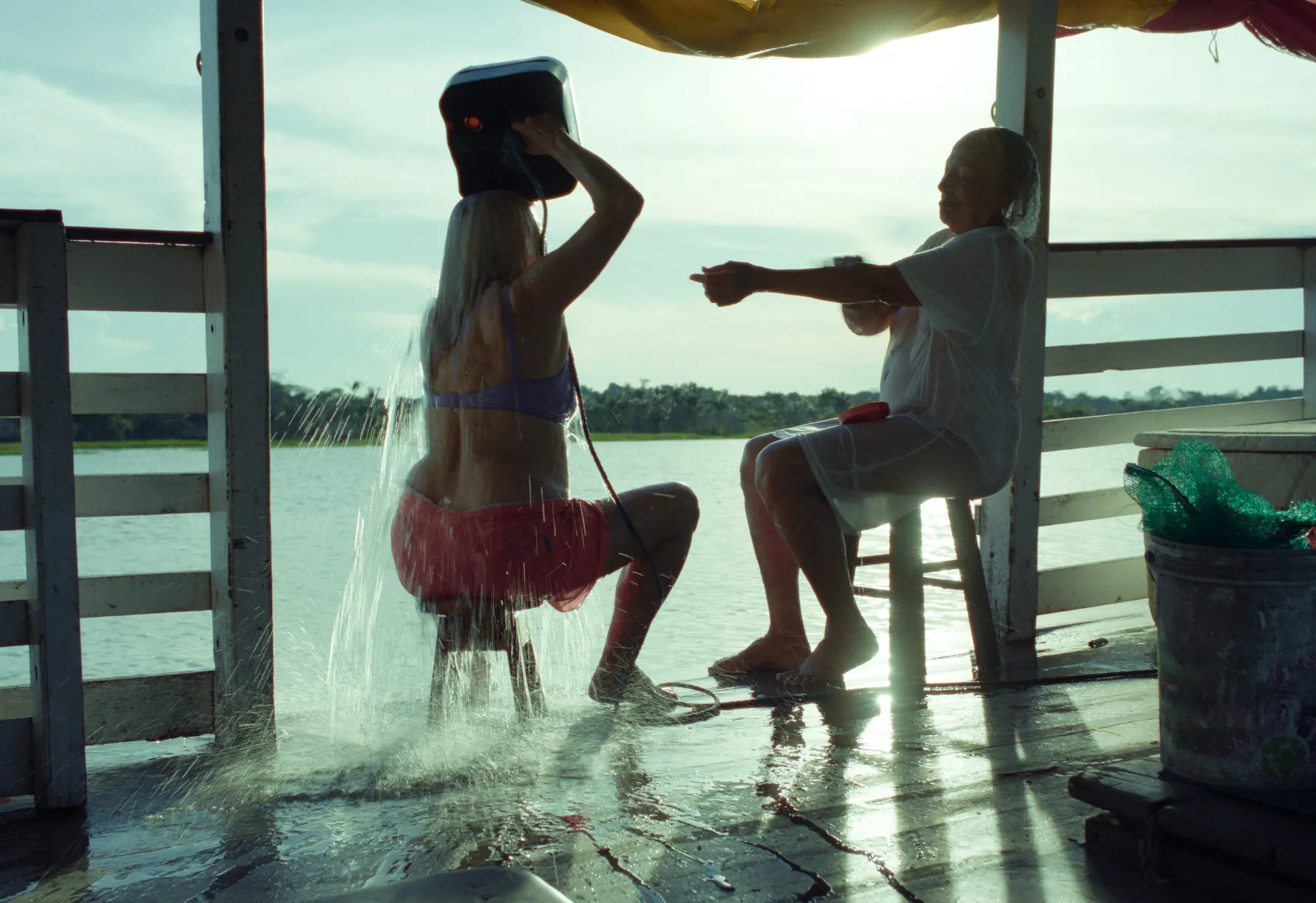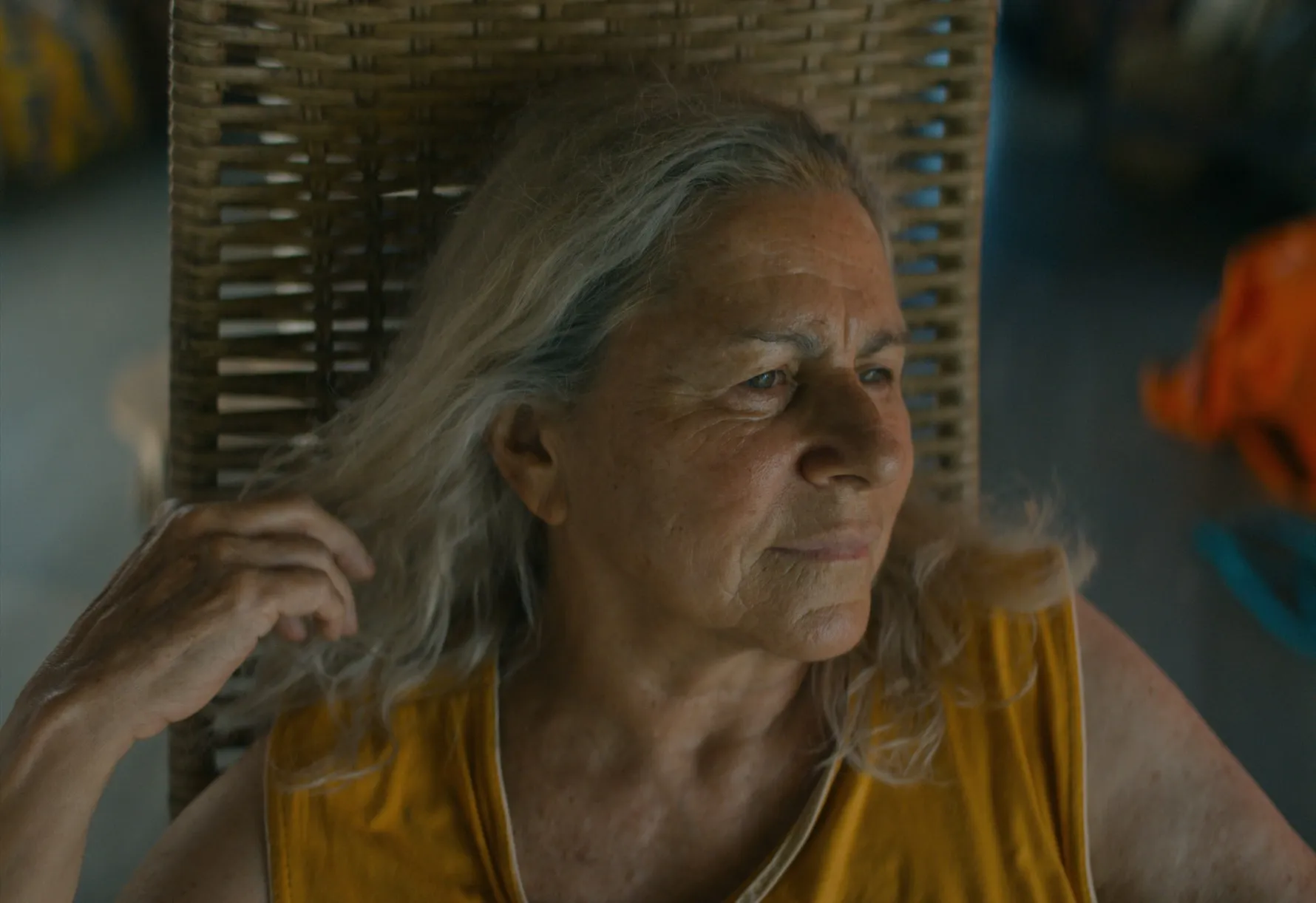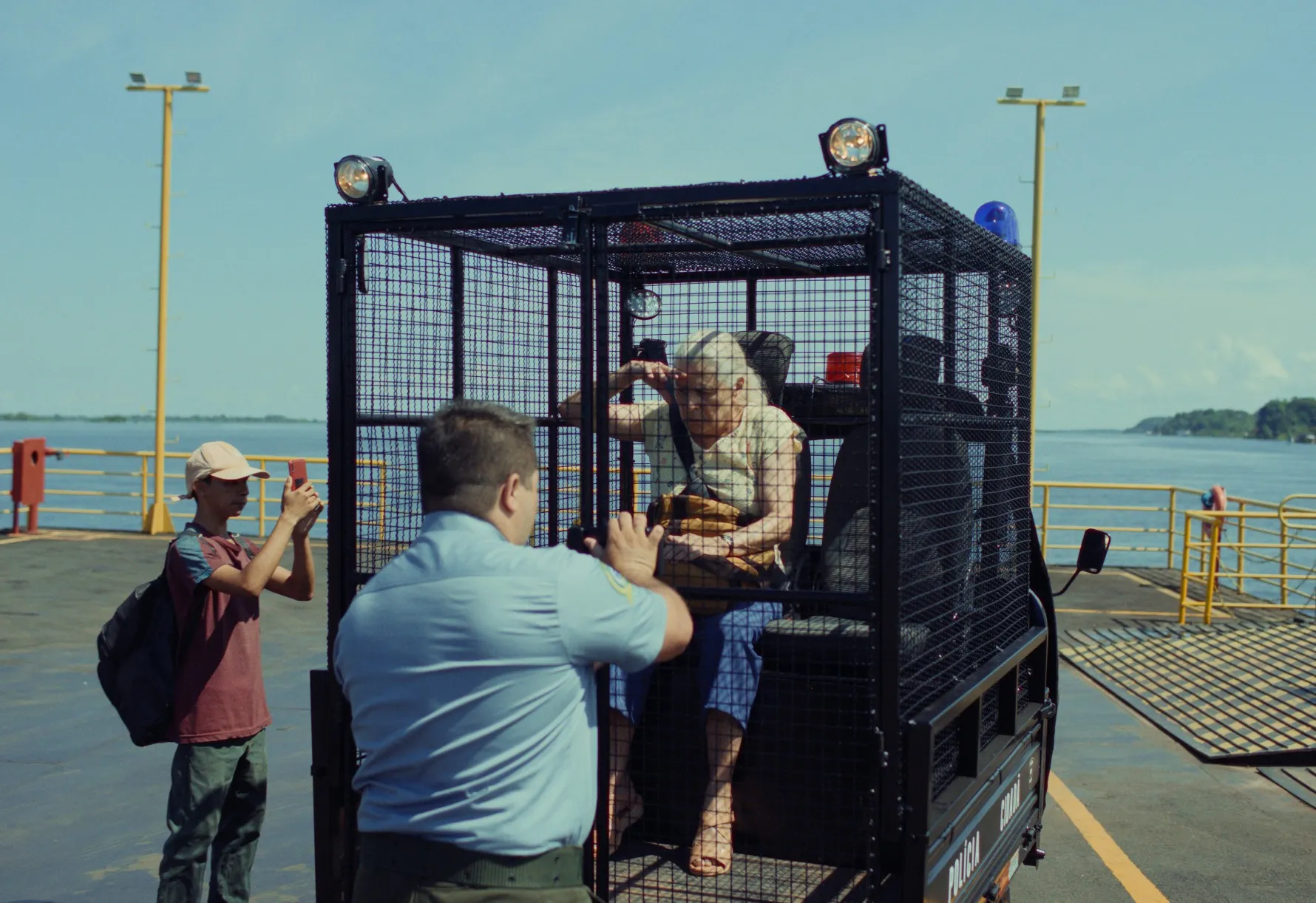Gabriel Mascaro’s The Blue Trail arrives as a feverish fable set amid the winding waterways of Brazil’s Amazonas, where shifting currents carry more than just river barges. It sketches a near-future society that venerates its elderly with gilded laurels even as it corrals them into a “Colony” at the age of seventy-seven—a compulsory exile disguised as honor. Here, propaganda planes streak the sky, broadcasting cheery slogans even as wrinkled citizens await the arrival of “Wrinkle Wagons,” open-caged vans that collect the unwilling and the defiant.
Into this paradox steps Tereza, a factory worker whose life of steady labor has skirted every daydream—until she learns her forced retirement is imminent. Denied permission by her own daughter to board a commercial flight, she sets out on a river-bound odyssey, guided by smuggler Cadu and buoyed by the promise of an ultralight adventure. The encounter with a bioluminescent snail, whose cerulean secretion unlocks buried longings, becomes the catalyst for Tereza’s rebellion.
Mascaro wraps the film in a sensorial embrace: sun-spattered riverbanks, the tactile pleasure of bucket baths, an electronic score that flickers between playful and haunting. At a brisk eighty-six minutes and framed in a close, 1.33:1 ratio, the movie offers an intimate canvas for its characters’ quiet revolutions—inviting us to drift along every meander as if each bend might reveal a new reason to seize one’s own destiny.
Charting the Meanders
From the first frame, Mascaro unfurls a world draped in propaganda: leaflets drifting like confetti from low-flying planes; booming announcements that “The future is for everyone.” Yet beneath the festive veneer lies the “Colony,” a state-sanctioned retreat where every citizen over seventy-seven is stripped of autonomy, handed to legally empowered offspring, and corralled into open-caged “Wrinkle Wagons.” This stark contrast between surface celebration and coercion sets the stage for Tereza’s revolt.
The narrative ignites when Tereza receives her mandatory retirement notice—her steady days at the alligator-meat plant abruptly ended—and learns that her daughter, Joana, will not sign off on a single travel document. Denied even a commercial flight, Tereza trades factory fumes for river currents, embarking on a voyage that transforms regulation into resistance.
Phase one introduces Cadu, a rum-soaked riverboat captain whose gruff exterior barely conceals his longing. Their uneasy alliance solidifies when they stumble across the luminescent “blue-drool snail.” Its psychotropic secretion induces feverish visions, prompting Cadu’s confession of a lost love and hinting at the emotional cargo each character carries.
At midstory, the quest for an ultralight flight in Itacoatiara collapses—mechanical failure leaves Tereza stranded beside a broken glider. In a smoky den called the Golden Fish, she glimpses chance’s cruel generosity and the arbitrary nature of hope.
Reinvigorated, she meets Roberta, the self-styled “Nun” peddling digital Bibles—a flamboyant entrepreneur who paid her way out of the Colony. Together, they sample the snail’s secret again, and Tereza’s aspirations outgrow the simple wish to fly.
As state agents close in, Tereza’s cunning emerges: a staged surrender, a commandeered craft, a slippered dance between capture and escape. The final shot lingers on her silhouette, airborne or adrift, a testament to a reclaimed life—and a question left echoing in open sky.
Faces of Liberation
Tereza, embodied with quiet steel by Denise Weinberg, enters the frame as a tireless laborer whose skepticism toward government paeans is etched in every crease of her face. Her early days at the alligator-meat plant reveal a body honed by routine—and yet, it is in the small rebellion of a factory-floor dance that Weinberg plants the first seeds of Tereza’s awakening. When buckets of river water become instruments of intimacy, each ripple across her skin speaks of an unspoken yearning for self-determined pleasure.
Rodrigo Santoro’s Cadu is carved from rough wood, yet his knots conceal a grain of vulnerability. His initial brusqueness gives way to a fevered confession under the snail’s cerulean trance—a moment that unravels both his heart and Tereza’s understanding of regret. Santoro treads carefully between the swagger of a smuggler and the trembling admission of a man haunted by lost love.
Miriam Socarrás arrives as Roberta, the digital-Bible “Nun” whose effervescent laughter contrasts sharply with the Colony’s clinical decrees. Her bravado is a lesson in self-purchase: freedom, she proves, can be brokered with currency as easily as it can be surrendered. In their shared moments of revelation, Socarrás and Weinberg forge a kinship that glows brighter than any government seal.
Clarissa Pinheiro’s Joana supplements the portrait of compliance, her bureaucratic reserve acting as a foil to her mother’s insurrection. Around them, co-workers and riverfolk inhabit the margins—silent witnesses whose bowed heads and startled glances betray an undercurrent of communal complicity.
Together, this ensemble sustains a living tableau: Weinberg and Socarrás trade glances that ripple with mutual trust, while Santoro subdues his star presence to anchor the film’s raw emotional core.
Under Currents of Meaning
The Blue Trail turns ageism into a living architecture of control. Elders are recast as economic “burden,” lauded with golden laurels only to lose guardianship of their own lives. Legal custody by adult children becomes a metaphorical leash, exposing dependency as a bureaucratic weapon.
Against this, the river’s sinuous course mocks straight-line productivity: its curves insist that value lies not in output but in the uncharted moments between departure and arrival. Even the slogan “The future is for everyone” drifts on the breeze as hollow reassurance, revealing propaganda’s bright skin and hollow core.
Regret and redemption ripple through Cadu’s confession: under the influence of the blue-drool snail, he bares a buried sorrow—a lost love that has become his silent compass. The snail’s luminescent secretion serves as a prism for buried histories, each drop refracting the possibility of rewinding time and rewriting regret.
Here, nature offers more than backdrop. The Amazon is a living sanctuary, its tributaries conduits of rebirth. A simple bucket bath becomes a ritual of cleansing, the river’s embrace dissolving the residue of enforced servitude. Water is both mirror and midwife, reflecting a self long obscured and ushering forth a new sense of being.
Magical realism flickers through each snail sequence and the surreal den of chance, where betting games elevate risk to ritual. Gastropod slime transforms into visionary ink, sketching fresh maps of desire. Meanwhile, Roberta’s purchase of freedom shows currency itself as a form of agency—capital transmuted into sanctuary. Every stake placed in the Golden Fish den underscores that fate can be wagered, that emancipation may hinge on a single, daring bet.
Frames of Liberation
Mascaro’s choice of the tall, narrow 1.33:1 frame invites an almost confessional proximity, squeezing the vast Amazonian expanse into an intimate portrait. Riverbanks slide past like stained-glass panels, each bend captured with a painterly economy. Close-ups on Tereza’s lined face feel weighty, while handheld moments—her fingers brushing the water’s surface—lend the camera a quietly reverent presence.
The color palette is a study in contrasts. Jungle greens surge with vitality, while sky-blue stretches overhead, unblemished. Water reflects both shades in rippling mosaics, and during the snail sequences a cerulean luminescence bleeds into Santoro’s trance, as if the river itself has been painted with otherworldly ink. Factory interiors, by comparison, sit in muted grays and browns, the harsh geometry underscoring Tereza’s initial confinement.
Long river-shot tableaux unfold in sweeping S-curves, evoking life’s unpredictable arcs. Static compositions linger on propaganda billboards and golden laurels pinned to huts, exposing hollow ceremonies of state. When the camera drifts into the meat-processing plant, sterile lighting and rusted machinery appear as a visual counterpoint to the wild opulence just beyond town. Every frame feels calibrated to expose the tension between mechanized order and organic freedom.
Magical-realist touches sparkle through the lens. Snail slime glows like liquid sapphire against Tereza’s palm, an alchemical lure. The Golden Fish gambling den emerges as a surreal stage, its neon-lit walls pulsing to the rhythm of high-stakes chance. Occasional drone-like inserts hover above the river, offering glimpses of flight that tease the viewer with the promise of escape—an aerial counterpoint to the river’s horizontal sweep.
Sonic Currents
Memo Guerra’s score pulses with electronic undertows and jazzy off-kilter rhythms, as if circuitry and heartbeat have fused into one restless organism. Where the narrative takes a jaunty, road-movie turn, the music snaps into buoyant motifs—bright percussion threading through spiraling synth lines. When Tereza pauses to reflect, those same electronics slip into hushed, contemplative textures, each sustained note hovering like mist over still water.
Diegetic sound anchors the film in its physical world: the thrum of factory conveyors, the steady slap of oar against river, insects chirping at dusk. Against this ambient tapestry, propaganda broadcasts intrude—peppy announcers layered over unsettling static—so that each promise of collective “honor” trembles with an undercurrent of menace.
Hallucination scenes twist the audio landscape into uncanny territory. Snail-induced visions arrive with echoing whispers and warped frequencies, as if the very air has been gently bent. In these moments, confession and confession overlap, voices trailing into silence. And when that silence finally falls—an abrupt pause in the aural rush—it lands like a physical weight, drawing attention to emotion itself, unadorned.
The Helm and the Lines
Mascaro refines his storytelling into a taut, elegant vessel—each scene stitched tightly into the next, dispensing with the languor that shadowed his earlier work. At eighty-six minutes, the film propels itself forward with a sense of purpose, yet retains moments of playful defiance: a factory-floor dance that undercuts its grim setting, a smirk exchanged over bureaucratic red tape.
Dialogue strikes a crisp, deliberate note. Tereza’s wry asides carry the weight of years lived in service to others, while exchanges between strangers—riverboat banter, marketplace whispers—reveal a society primed for compliance even as it simmers with dissent. Humorous beats emerge organically, whether in a travel agent’s officious coldness or the absurd formality of laurel presentations.
World-building seeps into the margins: graffiti scrawled on crumbling walls, gossip about vanished elders, radio static that crackles with half-heard rumors. Mascaro resists overt moralizing, trusting his images—golden laurels dangling like false promises, S-curving waterways—to deliver critique.
At the heart lies Tereza’s interior map. The screenplay charts her evolving desires—first survival, then curiosity, finally liberation—ensuring every choice she makes feels earned. Here, character and setting merge so seamlessly that the film’s one clear command is to keep steering toward autonomy.
Full Credits
Director: Gabriel Mascaro
Writers: Gabriel Mascaro, Tibério Azul
Producers: Rachel Daisy Ellis, Sandino Saravia Vinay
Executive Producers: Paulo Domingues, Rachel Daisy Ellis, Murilo Hauser
Co-Producers: Giancarlo Nasi, Marleen Slot
Cast: Denise Weinberg (Tereza), Rodrigo Santoro (Cadu), Miriam Socarrás (Roberta), Adanilo (Ludemir)
Director of Photography (Cinematographer): Guillermo Garza
Editors: Omar Guzmán, Sebastián Sepúlveda
Composer: Memo Guerra
The Review
The Blue Trail
The Blue Trail emerges as a tender yet pointed fable, weaving political urgency into a sensuous river pilgrimage. Mascaro’s brisk pacing, Weinberg’s commanding presence, and the film’s luminous imagery summon a quiet revolution against ageist indifference. Moments of whimsy and arresting critique cohabit seamlessly, turning each ripple into a manifesto of freedom. Its modest runtime brims with unspoken longing and reclamation, leaving its final frame lingering like a dare.
PROS
- Denise Weinberg’s portrayal of Tereza radiates quiet strength and warmth
- Intimate 1.33:1 framing heightens emotional connection
- Lush Amazonian vistas contrasted with stark propaganda imagery
- Memo Guerra’s score marries electronic textures and jazzy rhythms
- Taut, 86-minute screenplay balances urgency with poetic whimsy
- Subtle magical-realist touches enrich thematic depth
CONS
- Some side characters remain underexplored
- A few mid-journey scenes slow the narrative momentum
- Snail-vision sequences may feel overly whimsical to skeptics
- Brief runtime limits deeper exploration of secondary arcs




















































